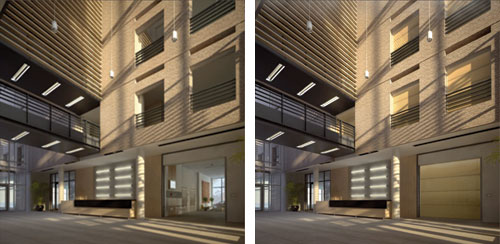Fire and Smoke Curtains: Meeting Atrium Code Requirements
To address these concerns, a new and simpler solution has come on the market: flexible smoke and fire barrier curtains. They have the added benefit of not being an impediment to design aesthetics since they are invisible when not deployed. These new systems can be selected as an alternative to meeting atrium code requirements or as a supplement to conventional approaches. Well-tested and used in Europe for a number of years, these systems are now available in the United States. They offer an intriguing, energy saving and cost-savings option for addressing code requirements for unenclosed openings such as an atrium, interior stair or escalator.
 |
Shown here, typical fire- and smoke-rated flexible curtains partially closing in a horizontal application. Fire-rated curtains rated up to 2 hours can be constructed of stainless steel strengthened glass filament fabric. Photo courtesy of Smoke Guard, Inc. |
ATRIUM DESIGN
The International Building Code (IBC), the most widely adopted building code in the U.S., and National Fire Protection Agency (NFPA) 101 "The Life Safety Code," NFPA's standard for regulating all components of the building impacting occupant life safety in the event of fire, have extensive code provisions for atrium designs with explanatory material spelled out in the IBC commentary and Life Safety Code Handbook.
 |
Smoke-rated flexible curtains before (left) and after (right) deployment. This unique system has primary and back-up power sources. Photos courtesy of Smoke Guard, Inc. |
A significant change in the 2006 IBC code regarding atrium designs and open spaces is that IBC has adopted NFPA 92B: Guide for Smoke Management Systems in Malls, Atria and Large Spaces, which allows design flexibility, with a corresponding wider range of approaches that can impact costs. Codes are interpreted differently by state and local building authorities, but the basic fire and smoke code provisions for atrium designs and open spaces are as follows:
- IBC defines an atrium as an opening connecting two or more stories other than enclosed stairways, elevators or escalators, which is closed at the top and not defined as a mall.
- The 2009 IBC code for an atrium permits multiple floors to be connected to one another by a floor opening provided that the building is protected by an electrically supervised sprinkler system and smoke management system. A two-story atrium is generally exempt from smoke control requirements. A three-story (or higher) atrium generally does require a smoke control system.
- IBC 404.6 requires that the floor openings forming the atrium be separated from occupied spaces by a 1-hr. fire-resistive construction or horizontal assembly. Exceptions to this requirement include: Exception 1 permits glazing to be utilized as a substitute for the one-hour separation where the nonrated glazing is protected by sprinklers located in close proximity to the glazing. Another exception to the separation requirement permits a maximum of three floors to be open to the floor openings forming the atrium if the volume calculated for the design of the smoke control system includes the volume of the spaces not separated from the atrium.
To be in compliance with code regulations for atrium designs, design professionals specify sprinkler systems, smoke management systems and fire-rated barriers.









